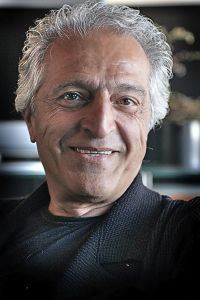Name Kamran Khavarani | Education University of Tehran | |
 | ||
Kamran Khavarani
Kamran Khavarani (born 1941) is an Iranian-American architect and painter. He has won multiple awards for his residential and commercial designs and a painter trained in the classical style. What may be his most notable achievement is the creation of a new style of painting called Abstract Romanticism, accredited to him by art historian Albert Boime of UCLA in 2005. His paintings have gained recognition from the Library of Congress and have been researched for their therapeutic effects.
Contents
- Kamran Khavarani
- Biography
- Style and Technique
- Selected Awards and Recognition
- Academic Research on Khavaranis Artwork
- References
Biography
Kamran Khavarani was born in 1941, in Tehran, Iran. He started painting at the age of 12. Khavarani was trained in classical painting by Reza Samimi. In 1966, he graduated from The University of Tehran having completed a Master's in Architecture and a PhD in Urban Design. Khavarani started his career as an architect. In 1965, his conceptual design for the City Theater of Tehran was selected by an international jury. Khavarani moved to the United States in 1981.
After he took residency in Los Angeles, California he had to start his architectural career all over. His first project in the States was in Beverly Hills. After the completion of that project in 1984, Khavarani won the CALBO Award of Excellence in the single-family category. He later designed the World Trade Bank of Beverly Hills, for which he won a design award from the City of Beverly Hills Architectural Commission.
Khavarani took painting more seriously after arriving in the States. In the 1990s, he started studying philosophy and found inspiration in the works of the Persian poet Rumi. Khavarani’s painting style was discovered by the late Professor Albert Boime, a Social Art Historian from UCLA. Boime wrote The Birth of Abstract Romanticism, Art for a New Humanity, Rumi and the Paintings of Kamran Khavarani, dedicating the entire volume to the works of Kamran Khavarani. Professor Albert Boime credited Khavarani for the creation of an artistic movement through his new style of painting, "Abstract Romanticism,” and called it a "one-person movement"
In 2010, Khavarani’s drawing, titled "The Bird of Freedom" was presented by Nowruz Commission to the spirit of Thomas Jefferson and accepted into the Library of Congress by James Hadley Billington. This presentation was officially noted in the Congressional Records and became part of the United States history. In 2011, the National Ethnic Coalition of Organizations awarded Khavarani the Ellis Island Medal of Honor in recognition of his contributions to America.
More recently, the healing power of his artwork has been the subject of three academic publications after researchers noticed that Khavarani's paintings at the Beverly Hills Cancer Center caused had a therapeutic effect on the patients.
Style and Technique
Khavarani is trained in classical painting, his early works were painted in this style. His works also include ink sketches and lifelike portraits In more recent years, his paintings are inspired by the Persian poet Jalal ad-Din Rumi. Rumi emphasizes the freedom of and individuality of creation obtained through love and joy and the fluidity of reinventing itself, but to viewers these connections are indistinguishable. Yet, his paintings hold the capacity to endow a heightened state of mind associated with the themes of Rumi. Common motifs of his paintings include plants: such as flowers and trees, the four elements: earth, wind, water and fire, and he uses the theme of creation or Genesis. This new style of painting is in the genre of "Abstract Romanticism", described by Albert Boime as: "The debut of a new art form, bringing emotion and beauty into the here and now. A dreaming for and of transcendence: an art for a new humanity".
Khavarani mainly paints with his hands and wears gloves to protect his skin. He also uses a mango seed for finer details.
Selected Awards and Recognition
Khavarani's most recognized achievement is the creation of "Abstract Romanticism". In an open letter to his art historian colleagues, Albert Boime wrote:
After 40 years of teaching and writing numerous art history books and articles, it is my last book "The Birth of Abstract Romanticism" that has truly been the culmination of my career. For anyone familiar with my work, you will notice that this book is radical departure from my previous writings. For once, just this once, I've written a book about a relatively unknown artist and a brand new art style – Abstract Romanticism – that can influence the history of art. Certainly his work goes against the grain of most international contemporary art in fact purports to offer an alternative to it. This constitutes a wonderful change that offsets the "ugliness" of so much bacchanalian and barbaric display that presently passes for art. It is my sincere wishes that his body of work may lead you into true beauty of visual art and uplift your spirit as it has mine.
Academic Research on Khavarani's Artwork
Khavarani's paintings have been the subject of a three-part research for their soothing effect on viewers' mood. This research is based on an extensive data, encompassing survey of 400 individuals. All three examine the aesthetic effect of Khavarani's paintings on the participants' psyche. In the first publication, with robust statistical evidence, it is shown that Khavarani's painting style has artistic characteristics that impart positive effect on individual's mental state. In the second study, the authors show that these effects are independent from the individuals' age, gender and pre–viewing mood. The third of the studies reports that the aesthetic effects of Khavarani’s paintings have a "lasting effect" on viewers' mood.
